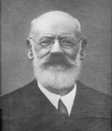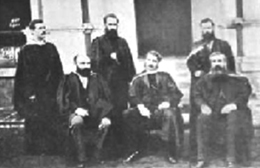|
It has been about 115 years since the establishment of Kodaikanal Observatory as an extension of the original Madras Observatory, which has evolved into the present Indian Institute of Astrophysics in Bangalore. It is also the first mountain observatory in India. Charles Michie Smith was the man who selected the site, established the observatory and directed it for the first 12 years. He was also the man who recruited John Evershed, discoverer of the famous Evershed effect, and established Kodaikanal Observatory as a major centre for solar physics. Michie Smith, the person, and the establishment of Kodaikanal Observatory are looked at here in the context of the early studies in physical astronomy (observational astrophysics) in India.

Charles Michie Smith.
The man who selected the site, established and equipped the Kodaikanal Observatory in 1899 in the face of major difficulties was Charles Michie Smith, a Professor of Physics at Madras Christian College, who slowly got lured into astronomy and became the Government astronomer at Madras Observatory first and then the founder-Director of Kodaikanal Observatory later. (Even after retirement from the Observatory he continued to live in Kodaikanal where he died and was buried there.)
The foundation for what he did was laid in a letter dated May 15, 1882 addressed to the Chief Secretary of the Government of Fort St. George by Norman Pogson, the Government Astronomer, who states, “I have the honour to supplement one very important suggestion ... upon the desirability of establishing a branch observatory, equipped with a large modern equatorial telescope at a hill station in South India.
“I strongly urge that a large new telescope should be ordered with as little delay as possible, to be placed at a hill-station, as far above sea level as convenient; but whether the Nilgiris or the Palani Hills would be best suited for the purpose, I am not yet prepared to advise...”
Pogson’s proposal was endorsed by the Governor in March 1883. “His Excellency believes... it would be in the interests of science to equip such an observatory as is indicated. No officer could probably be found better qualified to start a new station than Mr Pogson.” The Astronomer Royal, W.H.M. Christie, meanwhile, advised, “That the establishment of a branch observatory on the Pulney Hills in the Madurai district, seven thousand feet above sea level, would be the best for spectroscopic researches...’
The Governor requested Michie Smith, “a gentleman of considerable scientific attainments”, who was a Professor of Physics at Madras Christian College, also trained in practical astronomy and well acquainted with Pogson and the Madras Observatory, to undertake the site survey in Palani hills for a proper site for the observatory.

The Madras Christian College senate in 1880. G. Patterson is sitting on the
left, William Miller (Principal) in the centre and Charles Cooper on the right.
Standing (from left to right) are A. Alexander, G.M. Rae and Michie Smith.
Charles Michie Smith was born in Aberdeenshire, Scotland, to a minister of the Free Church and his wife. Charlie to all, he had to follow two brilliant elder brothers and inherited the legacy of being compared, unfortunately, with them, particularly by his father. The middle name Michie in Charlie’s name comes from his paternal grandmother. Charlie was the most practical of all the children and had a special interest in both woodwork and astronomy. His sister writes that even as a boy he had a workshop in a secluded corner of the garden equipped with a large work bench and a huge assortment of tools on which he had spent all his pocket money, of course, thoroughly disapproved by his father. His other interest was photography. He was taught at home by his father till he went to University. He suffered from his father’s ire through being a poor classical scholar, though brilliant at Maths, which “…at times distinctly strained the relationship between father and son so that he was pleased to leave home for King’s College in Aberdeen” in 1870. After graduating, with an MA at Aberdeen, Charlie went to Edinburgh to continue his scientific studies and ultimately got a B Sc degree in engineering.
After working in the Caribbean laying submarine cables, he got an appointment from the Free Church Foreign Missions Committee, Scotland, as a Professor of Mathematics and Physics at Madras Christian College (MCC).
Smith arrived in India in early 1877 at the age of 22 to take up the job at MCC. “Life in India appeared to suit him eminently. He threw himself vigorously into his work both at College and University. He started the Christian College Magazine and contributed articles on a variety of science subjects ranging from development of practical electricity, meteors, volcanic eruptions, zodiacal light and even the developments at Madras Observatory. He took much interest in physical training of youth in the Presidency. He became the joint secretary to the Madras Physical Training and Field Games Association which tried to encourage athletics in schools and colleges. He was secretary to the Madras Literary Society for a number of years. He was a member and President for several years of the Friends-in-Need Society. He took up responsibilities as a Fellow and, later, member of the Syndicate of Madras University for several years. He was from the start popular with the students.
All this was done while he continued his own researches on meteorology and astronomy. He participated in the activities of the Madras Observatory and was a great help to his friend Norman Pogson. He regularly communicated his researches to the Proceedings of the Royal Society of Edinburgh.
Because of his researches in meteorology and astronomy, the Governor considered Michie Smith “a gentleman of considerable scientific attainments” and invited him to conduct site survey in Palani hills for the branch observatory.
Smith conducted his site surveys for a hill observatory in two instalments covering the period May to July 1883 in the Palani hills and January 1885 in Doddabetta and its surroundings (the Nilgiris). His conclusions were that the site in Kodaikanal, on the western side, at a height of 7700 feet above sea level, with uninterrupted view of the horizons, was eminently suitable for a hill observatory.
The Governor urged very strongly the advisability of establishing a branch observatory in these hills, “where a large portion of clear nights may be confidently reckoned on during the year and where, owing to the absence of dust and haze, the conditions are most favourable.”
Meanwhile, Pogson became ill in June 1891 and was diagnosed as suffering from virulent cancer in the liver. His commitment to astronomy was such that he immediately tried to put his affairs in order and even wrote a letter to the Government about his possible successor. The letter stated, “The individual who is most intimately acquainted with the details and (steps) of my (past) labours in the Madras Observatory is Professor C. Michie Smith, B Sc. He is a Fellow of the Royal Astronomical Society and of the Royal Society of Edinburgh and has for several years past been entrusted by the Royal Society of London with a large and valuable spectroscope for researches on the Zodiacal light. I may add that he has undergone a course of training in Practical Astronomy under Dr. Copeland, Astronomer Royal of Scotland. I would therefore urgently advise and solicit as my dying wish that the said Professor C. Michie Smith might be appointed my successor as I am convinced that this alone will ensure my unfinished works would be completed as closely as possible as if I had lived to finish them myself....”
Pogson died on June 23, 1891, and the Madras Government appointed to the vacancy thus created “Mr C. Michie Smith, B.Sc., F.R.A.S., F.R.S. EDIN. as officiatory Government Astronomer. By August 5, 1892 Michie Smith completed further investigations of the two prospective sites for the hill observatory and submitted a report for the third time regarding their relative merits. The report was considered by both the Solar Physics Committee and the Indian Observatories Committee.
The Indian Observatories Committee, chaired by Lord Kelvin, resolved in October 1892 that the “Committee highly approves of the proposal to establish an Imperial Observatory for India on a site to be chosen in the highlands of Southern India” and also that “the Committee, from personal knowledge of Mr. Smith’s ability and attainments, are of opinion that he would be a very suitable Superintendent of the proposed Solar Physics Section of the Imperial Indian Observatory.” The Madras Government agreed to hand over the observatory to the Government of India and expressed a strong favourable opinion about Michie Smith, stating that “he was by his special scientific attainments and knowledge of the conditions of scientific work of India, peculiarly fitted for the appointment of Director of the Solar Physics Observatory.”
Finally, the Secretary of State for India in a letter dated August 31, 1893 to the Governor-General of India stated that after receiving endorsements from the Indian Observatories Committee through the Astronomer Royal’s letter and the Solar Physics Committee through the letter from its secretary, on the proposal of establishing on a small scale a new observatory at Kodaikanal in the Palani hills (under the Direction of Michie Smith), “I sanction your proposals, which involve an initial outlay of Rs 25,000 and yearly increase of Rs 1689.” The control of the Madras Observatory and the funds connected with it were transferred to the Government of India from April 1, 1894, placing the organisation and management of the new Solar Physics Observatory under the Meteorological Reporter of the Government of India. – (Courtesy: Current Science)
(To be concluded)
|

